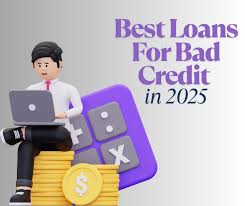Having a low credit score doesn’t mean you’re out of options. Personal loans for bad credit are designed to help borrowers with less-than-perfect credit gain access to funds for debt consolidation, emergencies, or major purchases. In this guide, you’ll learn how these loans work, what to watch out for, and tips to improve your approval chances — plus answers to the most common questions.
What Are Personal Loans for Bad Credit?
Personal loans for bad credit are loans offered to borrowers whose credit scores fall below the prime range (usually under 630 FICO). They can be secured (backed by collateral) or unsecured (no collateral required).
Key features:
- Loan amounts typically range from $1,000 to $50,000
- Repayment terms from 12 to 84 months
- Higher APRs compared to prime loans but lower than payday loans
- Flexible use: debt consolidation, medical expenses, car repairs, etc.
Why People Choose Personal Loans for Bad Credit
- Debt Consolidation: Roll multiple debts into one payment with a potentially lower rate.
- Emergency Expenses: Medical bills, urgent car repairs, or home maintenance.
- Credit Rebuilding: Making consistent on-time payments can improve your score.
- Flexibility: Unlike auto or student loans, personal loans can be used for almost any purpose.
Types of Personal Loans for Bad Credit
| Type | Description | Best For |
|---|---|---|
| Unsecured Loans | No collateral required, faster approval, higher interest rates | Borrowers without assets to pledge |
| Secured Loans | Collateral (car, savings, property) required, lower rates | Borrowers with assets who want lower rates |
| Co-Signer Loans | A co-signer with good credit improves approval odds and terms | Borrowers with supportive friends/family |
How to Qualify for Personal Loans for Bad Credit
- Check Your Credit Report: Correct errors that might be hurting your score.
- Compare Multiple Lenders: Online lenders, credit unions, and community banks.
- Show Proof of Income: Steady employment increases your approval chances.
- Lower Debt-to-Income Ratio: Pay down existing debts where possible.
- Consider a Co-Signer or Collateral: Improves your terms and lowers interest.
Where to Find Personal Loans for Bad Credit
- Online Lenders: Specialize in subprime borrowers; quick approvals.
- Credit Unions: Often more flexible with lower fees.
- Peer-to-Peer Platforms: Borrow directly from investors.
- Community Banks: May offer local programs with favorable terms.
Key Factors to Compare When Choosing a Loan
| Factor | Why It Matters |
|---|---|
| APR | Reflects the true cost of borrowing, including fees. |
| Loan Term | Longer terms mean smaller monthly payments but more total interest. |
| Fees | Origination fees, late fees, and prepayment penalties can add up. |
| Funding Time | Some lenders offer same-day or next-day funding. |
| Customer Reviews | Real experiences can highlight red flags. |
What to Watch Out For
- Predatory Lenders: Watch for extremely high APRs (over 36%) or vague terms.
- Hidden Fees: Ask about origination, late payment, or prepayment fees.
- Credit Impact: Each application triggers a hard inquiry. Apply selectively.
- Scams: Verify lender licenses and read independent reviews.
Steps to Improve Your Chances of Approval
- Build Your Credit Score: Pay bills on time, lower credit card balances.
- Borrow Only What You Need: Smaller loans are easier to get approved.
- Prepare Documentation: ID, pay stubs, bank statements, tax returns.
- Compare Offers Thoroughly: Don’t accept the first offer you see.
Pros and Cons of Personal Loans for Bad Credit
| Pros | Cons |
|---|---|
| Accessible even with low credit | Higher interest rates than prime loans |
| Flexible use of funds | May require collateral or co-signer |
| Fixed monthly payments | Origination fees may apply |
| Can improve credit with on-time payments | Approval not guaranteed |
Alternatives to Personal Loans for Bad Credit
- Credit-Builder Loans: Offered by credit unions to help establish credit history.
- Secured Credit Cards: Improve your score with responsible use.
- Borrow from Family or Friends: Interest-free but requires trust.
- Debt Management Plans: Work with a nonprofit credit counseling agency.
How to Use Personal Loans Responsibly
- Budget for Repayment: Ensure monthly payments fit your budget.
- Avoid Overborrowing: Only take the amount you truly need.
- Set Up Automatic Payments: Reduce risk of missed payments.
- Track Your Progress: Monitor your credit score improvement over time.
FAQs: Personal Loans for Bad Credit
Q1. Can I get a personal loan with a credit score under 600?
Yes. Many online lenders and credit unions specialize in subprime borrowers. Rates may be higher, but approval is still possible.
Q2. How much can I borrow with bad credit?
Typically between $1,000 and $50,000 depending on the lender, your income, and your overall profile.
Q3. Will applying for a personal loan hurt my credit score?
Each application creates a hard inquiry, which can slightly lower your score temporarily. On-time payments afterward can help it recover.
Q4. Are secured personal loans better for bad credit?
Yes, if you can provide collateral. Secured loans often have lower rates and higher approval chances.
Q5. How fast can I get approved?
Many online lenders offer same-day or next-day approval and funding, while traditional banks may take several days.
Q6. What’s the average interest rate for bad credit personal loans?
Rates vary widely, typically from 8% to 36% APR, depending on the lender and your credit profile.
Q7. Can I use a personal loan to consolidate debt?
Yes. Debt consolidation is one of the most common uses of personal loans for bad credit.
Conclusion
Getting a personal loan with bad credit is possible if you know where to look and how to prepare. By understanding your credit score, comparing multiple lenders, and borrowing responsibly, you can secure the funds you need — and even improve your financial health over time.
Whether you’re consolidating debt, paying for unexpected bills, or planning a major purchase, personal loans for bad credit can provide the lifeline you need. Just make sure to research thoroughly and pick a reputable lender with transparent terms.

